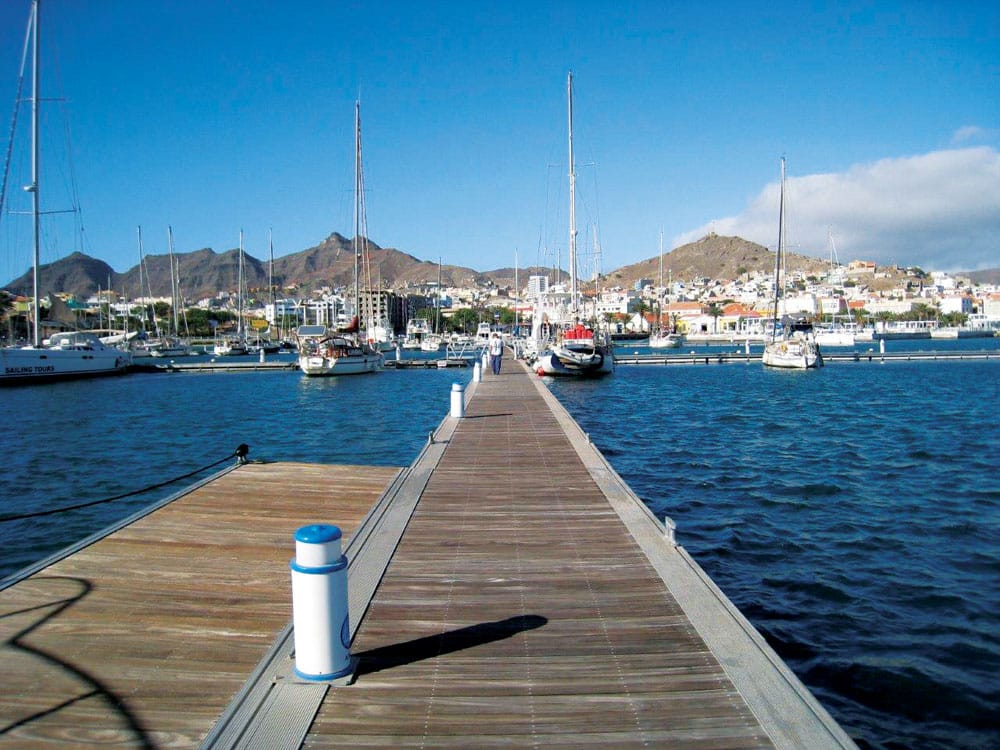



The Republic of Cape Verde lies 350 miles off the wild Atlantic coast of Africa. These once-barren uninhabited islands were discovered and colonized by the Portuguese in the 15th century, and were quickly established as a major part of the trans-Atlantic sea route for slave traders. The strategic position of these islands provided an important stopover point for general cargo ships and other mariners.
The early prosperity of these islands came at a cost, attracting unwanted attention from pirates, who often -plundered the -flourishing towns. Up until the early 18th -century, the slave trade was booming, but by -midcentury, there was a sudden decline, and it was finally abolished in 1876. As a consequence, these islands suffered financially, and a series of harsh droughts and extreme-weather conditions left the Cape Verde Islands crippled, forcing many of the residents to seek more-forgiving shores.
By the 19th century, the advent of ocean liners and larger cargo ships turned around the fortunes of Cape Verde, and these islands became a valuable trans-Atlantic stopping-off point once more. Ships transporting coal, water and livestock would dock in Mindelo Harbour on the island of Sao Vicente for fuel and other -supplies. In 1973, Cape Verde achieved its independence and gradually began to prosper. Today, the islands are a popular European-tourist destination.
By the turn of the century, more and more overseas investments in hotels and exclusive five-star resorts provided another boost to these islands. Tourists from around the world looking for new frontiers began to discover just how beautiful and diverse these islands truly are. Its struggling economy started to build again, which spawned new airports on many of the smaller surrounding islands, making it easier to handle more domestic and -international aircraft.
Game-Fishing
When guys like Capt. Berno Niebuhr started fishing these islands more than 17 years ago, little was known about species availability, let alone game fish. However, it didn’t take long for the local fishermen to find out that blue marlin frequented these waters for much of the year. Pioneering anglers also discovered that there wasn’t just the odd marlin here and there — they were plentiful, and big. Niebuhr, who now runs Happy Hooker on the island of Sao Vicente, has weighed 13 granders and released plenty of others. He also won two World Cup titles fishing these waters.
These days Mindelo Harbour boasts a new marina with eight -professional charter boats docked there. It’s not uncommon for any one of these -vessels to have two-dozen bites a day from blues, and to catch anywhere from six to a dozen, or even more. The other -interesting feature: There is no -consistency in their sizes. One hookup might be a 300-pounder, and the next, a solid 900 or even a grander.
As a result, plenty of international anglers are now giving the islands a great deal of attention. For me, it’s a place I’ve wanted to get to for quite a while. When my good mate Capt. Glen Johnno Johnson from Cairns, Australia, told me he was going to Cape Verde and invited me to join him, I jumped at the opportunity. Johnson was taking Gladius, a 50-foot G&S Express, there for saltwater fly-fishing angler, Fouad Sahiaoui. Their plan was to fly-fish for two months and, as it turned out, during that stretch Sahiaoui broke two world records: one on 16-pound -tippet weighing 269 pounds, and the other on 20-pound -tippet weighing 221 pounds.
Despite Sahiaoui’s good fortune on fly gear, trolling remains the go-to tactic for the area, and when you troll here, you pull big lures on heavy tackle because a grander could appear in the spread at any moment. Some -light-tackle anglers do get involved here with bait-and-switch techniques, but most of the time, the area’s -prevalent windy conditions present problems with this technique. Out of the two weeks I spent fishing Cape Verde with Sahiaoui, the highlight was watching him battle a blue for seven hours. Had the stars aligned correctly, this fish would have knocked off his own pending 20-pound record without question. We did spend a lot of time fishing with conventional gear, and when we did, we could generally count on -releasing five to 10 blues a day, some of which reached the 900-pound mark.
Fishing Season
The prime blue marlin season at Cape Verde lies between March and August, and the odd white marlin can turn up any time of the year. Other game fish, such as big yellowfin tuna and bigeye tuna, make regular appearances as well, but the months of August through December see the best numbers of tuna. Mahimahi and wahoo are often caught throughout the marlin season, and big amberjack are around most of the year too. For anglers keen on shark -fishing, big tigers and whale sharks roam these islands year-round, and during the more-temperate months between August and February, large makos make an -appearance as well.
Where to Stay
For the fisherman, the four-star Don Paco Hotel (donpacohotel.com) right across the road from the Mindelo Marina is the best place to stay. It’s a new, modern hotel with great rates, a friendly staff, and a good restaurant and bar. For the angler taking his family, there are a couple of very nice four-star hotels that offer more amenities, such as pools, golf courses and tennis facilities. To find out more, check with capeverdehotels.com.
Charter Contacts
Capt. Zak Conde — Amelia
; marlincapeverde.com
Capt. Marty Bates — La Onda;
fishing-capeverde.com
Capt. Clay Hensley — Hooker
; [email protected]
Capt. James Roberts — Hooker;
[email protected]
Capt. Brad Philipps — Hooker;
[email protected]
Capt. Migual Gamito — Dona Pi
; fishing-cape-verde.com
Capt. Berno Niebuhr — Happy Hooker
; capeverde-fishing.com
Capt. Matthias Henningsen — Smoker
; atlanticfishingcharter.com







